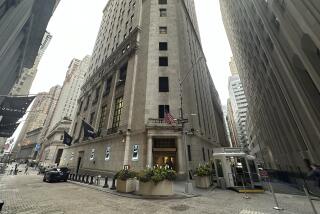Hope Seen in Jobless Figures
WASHINGTON — U.S. employers cut their payrolls by 17,000 jobs last month, the Labor Department reported Friday, enough to push the nation’s unemployment rate to a nearly nine-year high of 6.1%.
But the May jobs report also spurred hopes that the economy finally is emerging from its long slump.
The report, which contained a raft of revisions to past months’ figures, showed that though the economy lost more jobs last year than previously reported, it has lost fewer jobs this year than the Labor Department earlier said it had.
For economists on the lookout for any sign of revival, that constituted good news.
“We’ve got a declining trend in job losses, and that’s the first step to a jobs recovery,” said Rajeev Dhawan, an economic forecaster with Georgia State University in Atlanta.
Investors reacted to the new jobs figures by bolting out of the blocks early Friday, driving the Dow Jones industrial average up as much as 175 points. But by day’s end, that gain had been pared to 21.49 as the Dow closed at 9,062.79. U.S. Treasury bond prices slipped, nudging market interest rates slightly higher.
Analysts said that the most immediate effect of the jobs figures may be to curb Federal Reserve enthusiasm for a steep new cut in interest rates. Before Friday, many had predicted that Fed policymakers would slash their signal-sending federal funds rate half a point from an already four-decade-low 1.25% to 0.75%. Now, the betting is that policymakers will cut the rate only a quarter of a point to 1% when they meet June 24.
In Washington, Democrats pounced on the latest numbers as evidence of what they said was President Bush’s failed stewardship of the economy.
“The Bush economic record is clear: America is nearly $3 trillion deeper in debt and has lost more than 3 million jobs,” said House Minority Leader Nancy Pelosi (D-San Francisco).
Speaking for the administration, Labor Secretary Elaine L. Chao said that May’s job losses, though “disappointing,” were “in line with expectations and ... significantly lower than in previous months.”
The administration is counting on its just-approved $330-billion tax cut to lift the economy from its doldrums by spurring consumer demand and encouraging businesses to expand.
Analysts said Friday’s report was most important for what it showed about job trends earlier this year than for what it said about employment in May.
Only a month ago, the Labor Department estimated that the economy had shed 48,000 jobs in April and more than half a million since February. But in its new report, the department said there had been no job losses in April and 272,000 since February.
In essence, the revisions of previous months’ figures took some of the sting out of earlier job losses and suggested that the economy was not treading as close to the edge of an employment precipice as it had previously appeared.
“The revisions reinforce the picture of weakness but suggest that the economy is stabilizing” rather than sinking further, said Merrill Lynch & Co. economist Gerald Cohen.
Since peaking in early 2001, the economy has lost nearly 2.5 million jobs, about 650,000 more than initial government estimates showed.
As evidence that the economy is poised to grow again strongly, analysts pointed to a jump of 58,000 jobs in temporary-help services in May. Temp hiring often is a precursor to a recovery in the broader job market.
Among other job gainers during the month were the construction industry, which added 26,000 workers, and the financial services industry, which added 12,000, most of them to handle a boomlet in mortgage refinancing.
The nation’s manufacturers continued to shed workers for a 34th consecutive month, slicing payrolls by 53,000 in May. Since peaking in July 2000, manufacturing employment has dropped 2.6 million, or 15%, according to the Labor Department.
Government payrolls declined by 25,000 during the month, mostly the result of school layoffs.
Overall, the unemployment rate rose one-tenth of a point to 6.1%, with 9 million Americans counted as unemployed. The jobless rate for Latinos jumped substantially, from 7.5% in April to 8.2% in May. The rate for African Americans was little changed at 10.8%, the Labor Department reported.
The average workweek for production and nonsupervisory workers, who account for about three-quarters of the nation’s workforce, was unchanged at a relatively low 33.7 hours, after a decline of one-tenth of an hour in April.
Meanwhile, average hourly earnings rose 5 cents to $15.34, after no change in April. Over the last year, average hourly earnings have risen 3.2%.
More to Read
Inside the business of entertainment
The Wide Shot brings you news, analysis and insights on everything from streaming wars to production — and what it all means for the future.
You may occasionally receive promotional content from the Los Angeles Times.










